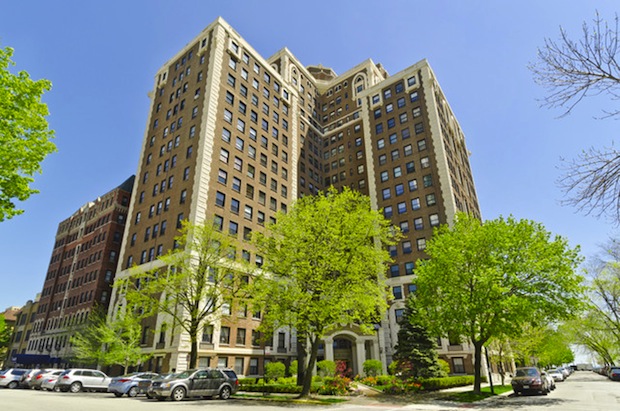Hyde Park’s Jackson Towers is one heck of a highrise—a brawny 19-story prewar at 55th and Everett designed by Walter W. Ahlschlager, the architect behind key Chicago landmarks like the Sheridan Plaza Hotel and the Uptown Broadway Building. As one of the old gems of the South Lakefront, the 72-unit building attracts scores of accomplished Hyde Parkers. But buying and selling in Jackson Towers has been a wild ride for several years now, and to the untrained eye very alarming.
On the one hand, Jackson Towers just notched its priciest sale ever—a 5,200 square-foot atrium duplex, largest in the building, that closed for $960,000 on October 31. The buyers are both professors at the University of Chicago and shopped several neighborhoods before landing here, won over by the unit’s grandeur and proximity to the lake and campus. “My buyers hope to make it a comfortable and inspiring place of intellectual and artistic gatherings in Hyde Park,” says KoenigRubloff agent Peggy Matson. The sellers sought $1.3 million when first listing in March, which brings me to the counterpoint: most of the units now listed or recently sold have endured major price reductions, as pricing guidelines for the three primary unit types have proven elusive in the wake of recession and large-scale building maintenance.
With multiple capital projects come multiple special assessments, which tend to scare off buyers. According to Matson, it appears all of these large projects are completed and there are no special assessments scheduled for foreseeable future. That’s a big plus for sellers, but the high monthly assessment (over $2,000 for the average duplex) needs as much justification as it can get. Right now, there’s a great level of service in the building, including 24-hour door staff, but there’s no signature amenity to compete with the pools and roof decks that certain luxury towers in Hyde Park and downtown bring to the table.
Residents are increasingly aware of this competitive disadvantage, says Vergis Eiland, a Coldwell Banker agent representing one fifth-floor duplex. There are inklings from residents that action may soon be taken to add at least one major selling point to the building—buyers need to feel their assessment is paying for something tangible. Another handicap is a lack of on-site parking, although there is a nearby garage popular with residents where you can get a space for around $200 a month.
The most captivating unit layout is the atrium duplex, which, with the exception of the $960,000 sale, clocks in between 3,000 and 4,000 square feet. This model has 20-foot cathedral ceilings in the main living area, often with Gaudi-esque contoured stucco, Juliet balconies, and open spiral staircases. Then there’s a traditional duplex sans high ceilings, and a simplex. The duplexes all exceed 2,500 square feet, and the simplexes are less standardized. A couple of smaller two-beds in decent shape, still with at least 1,500 square feet, are on the market for less than $100,000.
Eiland’s client has been trying to sell an atrium duplex, with views east to the water and south to the Museum of Science and Industry, since May 2013. Eiland took over the listing in March of this year and brought some reality back to the pricing—that as beautiful as the property is, it won’t be selling for anything close to the $1.2 million that the first broker attempted to justify. After several months of skidding, the new listing began at $624,900 and has more-or-less stabilized at $559,900. The sellers realize they had priced too high against their better judgment despite bringing more than $100,000 in renovations to the table, says Eiland. Bad luck, not bad pricing, has since kept the place from selling. “We had an offer from California fall through and another was withdrawn before we had a chance to counter,” says Eiland. He reports other recent interest.
Most of the 12 units currently on the market have had similar trajectories but are at different stages of the journey to right pricing. The disparate prices for same-sized, same-style units is a little mystifying but it underscores the difficulty in reconciling asking price with high assessments and housing’s uneven recovery. Matson also points to a wide range of condition. “The bones of a unit may be quite grand, but in need of extensive work to be brought up to modern standards,” she says. “The lower prices paid for these units should allow the new owners to do the needed renovations and I expect the prices when resold will be much higher.” She also suspects a lot of owners were underwater through the recession, and those attempting to sell at prices obviously out of step with the neighborhood were only trying to protect themselves. Distressed sales and estate sales have dragged down comps.
There is less of that now, says Matson. “Prior to the latest real estate downturn the units turned over quite easily. I expect Jackson Tower will see improved prices and market times.”



